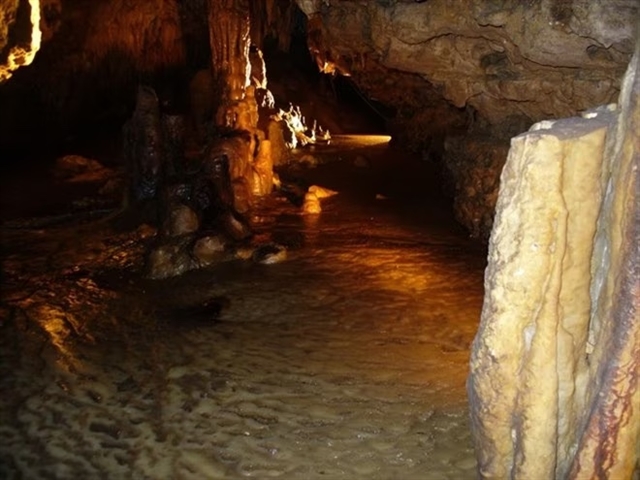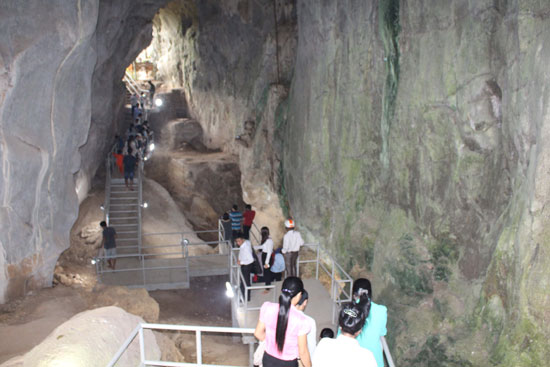
Con Moong Cave can satisfy UNESCO world heritage criteria of cultural tradition, traditional human settlement and natural habitat. — VNA/VNS File Photo
THANH HÓA — Experts and scientists have looked into seeking UNESCO world heritage site recognition for Con Moong Cave in the central province of Thanh Hóa.
The scientific conference on evaluating the possibility of and determining criteria for UNESCO world heritage recognition for the Con Moong Cave area at Thạch Thành District was jointly held by the provincial Department of Culture, Sports and Tourism, the Institute of Archaeology, and the Việt Nam Archaeological Association (VNAA).
Participants evaluated the outstanding values of the cave and its surrounding areas based on excavation and research results from 1976 to present, and exchanging experience and criteria for a dossier to submit to UNESCO.
Associate Professor Dr. Đặng Văn Bài, deputy chairman of the National Cultural Heritage Council, suggested Thanh Hóa Province pay more attention to consulting experts from the International Council on Monuments and Sites (ICOMOS) in this regard.
ICOMOS's on-site consultations and inspections are the basis for the World Heritage Committee to issue decisions related to cultural heritage. At the same time, Thanh Hóa Province needs to build a good scientific dossier to submit to UNESCO to recognise Con Moong Cave as a World Heritage Site.
In his closing remarks, VNAA Chairman Assoc. Prof. Tống Trung Tín said participants shared the view that the cave can satisfy selection criteria regarding cultural tradition, traditional human settlement and natural habitat.
Tín also said that Thanh Hóa Province needs to establish a provincial committee to lead and direct relevant units to coordinate with the central Government to develop the heritage area documents and dossier.

Visitors at Con Moong Cave. — VNA/VNS File Photo
Con Moong Cave, first excavated by Vietnamese archaeologists in 1974, is located inside Cúc Phương National Park in Thành Yên Commune, Thạch Thành District, Thanh Hóa Province.
Con Moong, which means “animal” in the Mường ethnic minority language, is 147m above the sea level and belongs to the Đồng Giao geological layer dating back 240 million years.
It measures some 40m in length, with openings on both ends. Inside the cave, the ceiling at some places is 10m high.
From 2010 to 2014, Con Moong Cave and the surrounding areas were systematically excavated and researched within the framework of a cooperative project between Việt Nam Institute of Archaeology, Việt Nam Academy of Social Sciences, Novosibirsk Institute of Archaeology and Ethnography, Russian Academy of Sciences and the Department of Culture, Sports and Tourism of Thanh Hóa Province.
The heritage area of Con Moong Cave includes dozens of caves and stones distributed in a space of more than 20,000 hectares of Cúc Phương National Park in Thạch Thành District and some areas in Hòa Bình and Ninh Bình provinces.
The cave has been excavated many times and determined to be the oldest site in the country containing traces of ancient humans from the Palaeolithic to the Neolithic period, from about 60,000 years to 7,000 BC.
The cave is where the ancient Vietnamese people settled, whose three cultures are Sơn Vi, Hòa Bình and Bắc Sơn. Evidence found here from traditional human settlements indicates they hunted animals, gathered fruits and farmed.
In 2020, the Prime Minister approved a plan to preserve, restore and promote the value of the archaeological relics of Con Moong Cave and surrounding areas with a total area of 977,568 hectares. The cave was recognised as a Special National Archaeological Site by the Ministry of Culture, Sports and Tourism in 2015. — VNS
OVietnam